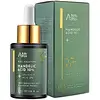What's inside
What's inside
 Key Ingredients
Key Ingredients

 Benefits
Benefits

 Concerns
Concerns

 Ingredients Side-by-side
Ingredients Side-by-side

Water
Skin ConditioningGlycerin
HumectantButylene Glycol
HumectantDimethicone
EmollientC12-15 Alkyl Benzoate
AntimicrobialHydrogenated Polyisobutene
EmollientNiacinamide
SmoothingSodium Hyaluronate
HumectantHydrolyzed Sodium Hyaluronate
Skin ConditioningCetearyl Alcohol
EmollientCetearyl Glucoside
EmulsifyingCeramide NP
Skin ConditioningCeramide AP
Skin ConditioningCeramide EOP
Skin ConditioningCeramide Ns
Skin ConditioningPhytosphingosine
Skin ConditioningCholesterol
EmollientSodium Lauroyl Lactylate
EmulsifyingPolyacrylamide
C13-14 Isoparaffin
EmollientLaureth-7
EmulsifyingTocopheryl Acetate
AntioxidantCamellia Sinensis Polyphenols
AntioxidantMalus Domestica Fruit Cell Culture Extract
Skin ConditioningPEG-40 Stearate
EmulsifyingStearyl Alcohol
EmollientBehenyl Alcohol
EmollientCetyl Alcohol
EmollientTetrapeptide-21
Skin ConditioningResveratrol
AntioxidantCaffeine
Skin ConditioningLecithin
EmollientGlyceryl Stearate
EmollientXanthan Gum
EmulsifyingCarbomer
Emulsion StabilisingPhenoxyethanol
PreservativeSorbic Acid
PreservativeCaprylyl Glycol
EmollientPotassium Hydroxide
BufferingTitanium Dioxide
Cosmetic ColorantDisodium EDTA
Water, Glycerin, Butylene Glycol, Dimethicone, C12-15 Alkyl Benzoate, Hydrogenated Polyisobutene, Niacinamide, Sodium Hyaluronate, Hydrolyzed Sodium Hyaluronate, Cetearyl Alcohol, Cetearyl Glucoside, Ceramide NP, Ceramide AP, Ceramide EOP, Ceramide Ns, Phytosphingosine, Cholesterol, Sodium Lauroyl Lactylate, Polyacrylamide, C13-14 Isoparaffin, Laureth-7, Tocopheryl Acetate, Camellia Sinensis Polyphenols, Malus Domestica Fruit Cell Culture Extract, PEG-40 Stearate, Stearyl Alcohol, Behenyl Alcohol, Cetyl Alcohol, Tetrapeptide-21, Resveratrol, Caffeine, Lecithin, Glyceryl Stearate, Xanthan Gum, Carbomer, Phenoxyethanol, Sorbic Acid, Caprylyl Glycol, Potassium Hydroxide, Titanium Dioxide, Disodium EDTA
Water
Skin ConditioningMandelic Acid
AntimicrobialNiacinamide
SmoothingSimmondsia Chinensis Seed Oil
EmollientOligopeptide-1
Skin ConditioningPortulaca Oleracea Extract
Skin ConditioningSalicylic Acid
MaskingAcacia Senegal Gum
MaskingMelaleuca Alternifolia Leaf Oil
AntioxidantHyaluronic Acid
HumectantTocopheryl Acetate
Antioxidant3-O-Ethyl Ascorbic Acid
Skin ConditioningIsononyl Isononanoate
EmollientRetinol
Skin ConditioningSaccharide Isomerate
HumectantCaprylhydroxamic Acid
Glyceryl Caprylate
EmollientPentylene Glycol
Skin Conditioning1,2-Hexanediol
Skin ConditioningWater, Mandelic Acid, Niacinamide, Simmondsia Chinensis Seed Oil, Oligopeptide-1, Portulaca Oleracea Extract, Salicylic Acid, Acacia Senegal Gum, Melaleuca Alternifolia Leaf Oil, Hyaluronic Acid, Tocopheryl Acetate, 3-O-Ethyl Ascorbic Acid, Isononyl Isononanoate, Retinol, Saccharide Isomerate, Caprylhydroxamic Acid, Glyceryl Caprylate, Pentylene Glycol, 1,2-Hexanediol
 Reviews
Reviews

Ingredients Explained
These ingredients are found in both products.
Ingredients higher up in an ingredient list are typically present in a larger amount.
Niacinamide is a multitasking form of vitamin B3 that strengthens the skin barrier, reduces pores and dark spots, regulates oil, and improves signs of aging.
And the best part? It's gentle and well-tolerated by most skin types, including sensitive and reactive skin.
You might have heard of "niacin flush", or the reddening of skin that causes itchiness. Niacinamide has not been found to cause this.
In very rare cases, some individuals may not be able to tolerate niacinamide at all or experience an allergic reaction to it.
If you are experiencing flaking, irritation, and dryness with this ingredient, be sure to double check all your products as this ingredient can be found in all categories of skincare.
When incorporating niacinamide into your routine, look out for concentration amounts. Typically, 5% niacinamide provides benefits such as fading dark spots. However, if you have sensitive skin, it is better to begin with a smaller concentration.
When you apply niacinamide to your skin, your body converts it into nicotinamide adenine dinucleotide (NAD). NAD is an essential coenzyme that is already found in your cells as "fuel" and powers countless biological processes.
In your skin, NAD helps repair cell damage, produce new healthy cells, support collagen production, strengthen the skin barrier, and fight environmental stressors (like UV and pollution).
Our natural NAD levels start to decline with age, leading to slower skin repair, visible aging, and a weaker skin barrier. By providing your skin niacinamide, you're recharging your skin's NAD levels. This leads to stronger, healthier, and younger looking skin.
Another name for vitamin B3 is nicotinamide. This vitamin is water-soluble and our bodies don't store it. We obtain Vitamin B3 from either food or skincare. Meat, fish, wheat, yeast, and leafy greens contain vitamin B3.
The type of niacinamide used in skincare is synthetically created.
Learn more about NiacinamideTocopheryl Acetate is AKA Vitamin E. It is an antioxidant and protects your skin from free radicals. Free radicals damage the skin by breaking down collagen.
One study found using Tocopheryl Acetate with Vitamin C decreased the number of sunburned cells.
Tocopheryl Acetate is commonly found in both skincare and dietary supplements.
Learn more about Tocopheryl AcetateWater. It's the most common cosmetic ingredient of all. You'll usually see it at the top of ingredient lists, meaning that it makes up the largest part of the product.
So why is it so popular? Water most often acts as a solvent - this means that it helps dissolve other ingredients into the formulation.
You'll also recognize water as that liquid we all need to stay alive. If you see this, drink a glass of water. Stay hydrated!
Learn more about Water